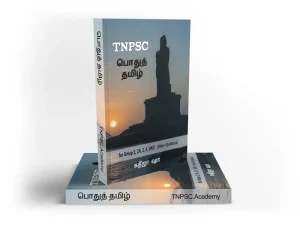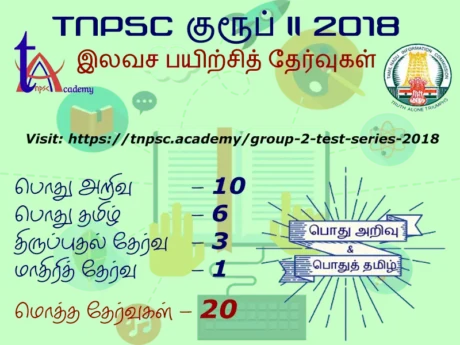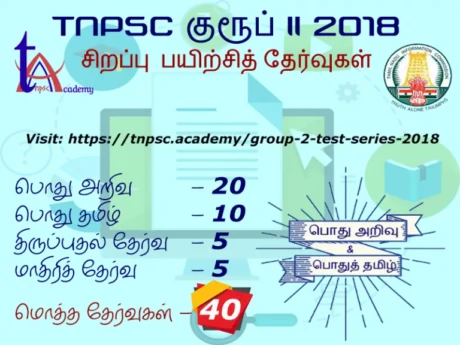TNPSC Books
-
TNPSC பொதுத் தமிழ் Book - for Group 2, 2A, 3, 4 & VAO
₹1,000.00Original price was: ₹1,000.00.₹850.00Current price is: ₹850.00. -
TNPSC General English Book - for Group 2 & 2A
Rated 5.00 out of 5₹1,000.00Original price was: ₹1,000.00.₹850.00Current price is: ₹850.00.
Group 1 Courses
Group 1 | Postal and Online Test Series | 2022
₹3,200.00Original price was: ₹3,200.00.₹2,800.00Current price is: ₹2,800.00. 88TNPSC Group 1 - Test Series - 2019
4.7₹3,500.00Original price was: ₹3,500.00.₹2,800.00Current price is: ₹2,800.00. 542
Group 2 & 2A Courses
TNPSC Group 2 and 2A - Test Series - 2019
₹2,400.00Original price was: ₹2,400.00.₹1,800.00Current price is: ₹1,800.00. 527TNPSC Group 2 and 2A - Test Series - 2019 - தமிழ்
₹2,400.00Original price was: ₹2,400.00.₹1,800.00Current price is: ₹1,800.00. 175














Empowered Women Navigating the World
Gone are the days, where women in India remained indoors unless permitted to go out with an escort. Conditions today have changed, thanks to all those women who have fought for their freedom and set a very good example for others. The real power of women though realised earlier, is currently being projected to the world by the advancement of technology and media.
Women occupy almost all the major positions in society. Currently, women’s accomplishments are tremendous in many fields. One such achievement is the All-women Indian Navy crew who circumnavigated the world for 254 days all alone, in a sailboat called INSV Tarini.
What is INSV Tarini?
INSV stands for Indian Naval Ship Vessel. Tara-Tarini is the patron deity for sailors and is worshipped for safety and success at sea.
INSV Tarini is the second sailboat of the Indian Navy (The first being the INSV Mhadei). It is a 55 foot sailing vessel built indigenously in India by M/s Aquarius Shipyard Pvt. Ltd, located in Goa. After undergoing extensive sea trials, she was commissioned to the Indian Navy service on 18 February 2017. The boat was named after the famous ‘Tara-Tarini’ temple in Ganjam district of Odisha. The word ‘Tarini’ means ‘boat’ and in Sanskrit it means ‘Saviour’.
INSV Tarini has an advanced Raymarine navigation suite and an array of satellite communication systems for perfect navigation anywhere in world.
Navika Sagar Parikrama was a project undertaken in consonance with the National policy to empower women to attain their full potential. “The Project is considered essential towards promoting ocean sailing activities in the Navy while depicting Government of India’s thrust for Nari Shakti (women power),” said Chief of the Naval Staff, Admiral Sunil Lanba in his welcome speech.
The voyage was aimed to showcase ‘Make in India’ initiative by sailing onboard indigenously built INSV Tarini. The special feature of this sailboat was that it encouraged the use of environment friendly non-conventional renewable energy resources such as the wind; collected and updated meteorological, ocean and wave data on regular basis for accurate weather forecast by India Meteorological Department (IMD) and also collected data for monitoring marine pollution on high seas.
Indian Navy’s Six Women Crew
Indian Navy’s all-women crew was the first-ever to circumnavigate the globe skippered by Lt. Cdr. Vartika Joshi. The all-women team has also Lt. Cdr. Pratibh Jamwal, Lt. Cdr. Swathi Patarapalli, Lt. Aishwarya Boddapati, Lt. Vijaya Devi and Lt. Payal Gupta as its crew members.
The crew started their voyage on 10 September 2017 from Goa, flagged off by the Defence Minister of India. It was a historic day, which would be marked in navigation history and globally. It covered the expedition in five legs with stopovers at four ports (Fremantle, Australia; Lyttleton, New Zealand; Port Stanley, the Falklands and Cape Town, South Africa) for replenishment of ration and repair as necessary, before returning to Goa in April 2018. They went around the globe within 254-days and reached Goa port on 21 May 2018. The six member women crew broke many stereotypes during their record-setting sail.
An Interview with the crew members
India’s all-women navy crew who went around the world in 254-days have shared their experiences about their great voyage in an interview. Through their personal experiences, we really come to know their hardships and unpredictable challenges they have faced all through their expeditions.
Interviewer: How well were you acquainted with the sail boat before you took up the task?
Vartika Joshi: None of us was acquainted with a sail boat or ocean-going boat; none of us had sailed before, nor are woman officers allowed entry in combat platforms as yet. At first, it was difficult to take the boat out to sea, from one point to another. But we slowly built upon it through three years of training.
Interviewer: Can you tell us about the training you had undergone before this expedition?
Vartika Joshi: We started with some theoretical courses on navigation, communication and weather prediction. Classroom courses are different from sailing outside. So, we were given hands-on training, like, how to repair things and how to deal with emergencies, when the weather gets rough, if there is a medical emergency, and training was needed in tactical aspects as well.
Aishwarya: We underwent our basic sail training courses in Mumbai at the Indian Naval Waterman ship Training Centre (INWTC), and at various schools in the southern naval base in Kochi. We even sailed on INSV Mhadei to Mauritius (in 2016 and 2017) and back and also to Cape Town in December 2016. We were trained for almost three years to prepare for the voyage. Since the boat was old, it had minor leaks and repairs. Also, we ran out of water and food soon. So the trip was a tutorial for us on how to manage food, water and even electricity during the big voyage.
Interviewer: What was the selection process?
Aishwarya: Out of the thirty women who had applied, six of us were shortlisted, based on the little survival skills we showcased. The crew was mentored by Commander Dilip Donde. But after I was told about the flare-ups at sea, I even had second thoughts about joining the team.
Interviewer: How did your family members react when you told them about this expedition?
Vartika Joshi: Our families did have a hard time, but that was because most of them had never even seen the sea! Four of us are from the mountains. The first time my parents saw the ocean was when I invited them to visit. But once they saw that we’re doing well and looking after ourselves, they were quite supportive. They were apprehensive and supportive too.
Interviewer: What were your aims and how did you work to achieve them?
Vartika Joshi: I wanted to make sure that I complete this journey with ultimate honesty. I didn’t set out for a destination; it was the journey that mattered to me the most. So my contention was to make sure that we go by the rules of circumnavigation which say that you don’t have to use any auxiliary means of repulsion and you don’t
have to take anybody else’s assistance. I grasped that completely.
Interviewer: Name that one quality of yours that enabled you to complete this expedition successfully?
Vartika Joshi: Whenever the winds dropped, it wouldn’t have taken me even a fraction of second to switch on the engine and say let’s go one mile ahead. But inside of me something poked me and said that you have to be honest with yourself and this expedition has to be done with honesty. I am glad that we were able to finish it successfully without the use of the engine at all.
Interviewer: As the head of the crew, how did you involve the team?
Vartika Joshi: We’ve all sailed and trained the same amount, and everybody has their own way of dealing with situations, but that was a good thing, because we could discuss different ways of solving a problem and choose the best one. In fact, I’d say it was easier for us to collaborate and work together.
Payal Gupta: When you are out at sea, teamwork is the most important in the middle of the crisis. Even during the storm when three people would be out on watch, the other three who would be inside wouldn’t be able to rest. Somebody would heat the water, the other person would heat the gloves because it was raining also. So team effort actually helped in navigating through the 20 hours long storm. I feel that if I had been alone then it would have been a nightmare to deal with the challenges that the sea throws at you.
Interviewer: Share your experience about the most challenging task while sailing.
Vartika Joshi: The Sea can get really tough when winds are picking up. Those are the times we have to be active and need to anticipate what could be there ahead. In the South Pacific, we encountered a storm where the seas were almost nine to ten meters high and the winds were picking up to 60–70 knots(a unit of speed equal to one nautical mile per hour exactly 1.852km/h), which is about a hurricane force of wind on land. It is normal on sea where there is hardly any land mass to stop the winds.
It was also a blissful experience when something broke down and after a lot of hard work and effort, we were able to fix it together. We will remember these incidents as well because they gave us the strength to move on and if something went bad, we were able to overcome those challenges.
Interviewer: What were the exciting moments during the trip?
Vartika Joshi: When we were crossing the Tasman Sea, we witnessed the brilliant Southern Lights from sea. It was rare to watch that in those months, that too from sea. We were absolutely awestruck as we were not expecting it, to see the entire sky lit up in green light. There was bio-luminescence, dolphins swimming in the wake of the boat like our neighbours and a variety of sea creatures. We spotted a dead sperm whale once and we thought it was an island from a distance, it was so huge. We are not specialists, so whenever we spotted something in the sea, we had to Google it to learn more about the species.
Interviewer: How did your crew spend time deep in the sea?
Swathi P: During circumnavigation, we picked up some hobbies and kept posting pictures of delicacies like golgappas and cakes. We also read books when the weather was pleasant and did some quilling and craft work. While team leader Joshi read comics and the Ramayana during her journey, I loved cooking as well so I indulged in baking. I also liked crafting a lot, so I used to make lampshades. I love it when people appreciate the food that I cook, so I gave my crew members the best dishes that was possible on land with the limited resources that we had on the boat.
Vartika Joshi: Six is a great number, we were always entertained. We watched movies, listened to music, and you won’t believe some of the goodies the crew rustled up in our tiny pantry, even while sailing in rough seas. We made parathas, baked cakes and breads, and even made halwa and rasgullas!
We celebrated festivals at sea. When we think about it now on land, we remember the Diwali we spent at sea. We celebrated three birthdays including the first birthday of the boat; also specific occasions like crossing the equator, the International Date Line and such.
Interviewer: What motivated you to fulfil the country’s expectations?
Swathi P: We knew that the entire country was watching us and praying for us, so we never wanted them to have a single day thinking that we are in trouble. We knew that it is going to happen but the people out there did not know what kind of challenges we were facing. So, one of the motives that we kept in mind was that we did not want to frighten them. We decided that once the circumnavigating was over, we are going to show what we have actually gone through.
Interviewer: As a woman, how would you consider this expedition?
Vartika Joshi: It is a matter of great honour and we couldn’t have imagined anything better for our cast-off. Of course we being an all-woman team, it is a great boost to women in the country. But, as we are going as sailors, and we as sailors have seen that the sea does not discriminate between genders. It is always genderneutral and we have realised that gender does not play a role in sailing. But to boost the morale in the country and for more women to take in adventures like sailing, I feel it is great that an all-woman team had been formed to undergo this expedition.
Glossary
circumnavigate (v) – to travel all the way around something, especially the Earth
indigenously (adv.) – naturally; innately; inherently
consonance (n) – agreement or compatibility between opinions or actions
skippered (v) – acted as a master or captain of a vessel especially a small boat
expedition (n) – a journey or voyage made for some specific purpose, such as of war or exploration
replenishment (n) – restoration of a stock or supply to a former level or condition
apprehensive (adj.) – anxious or fearful that something bad or unpleasant will happen
contention (n) – strenuous effort; struggling together in opposition
auxiliary (adj.) – additional; used as a reserve or substitute in case of need
anticipate (v) – to foresee; to realize beforehand; to expect; be sure of
bio-luminescence (n) – the production of light by living organisms
golgappas (n) – the other term for pani puri
morale (n) – emotional or mental condition with respect to confidence especially in the face of hardships
Do You Know?
The first Indian solo circumnavigation was undertaken by Capt. Dilip Donde, (Retd.) from August 19, 2009, to May 19, 2010 on board another India-built vessel INSV Mhadei.
The first Indian non-stop solo circumnavigation was undertaken by Cdr. Abhilash Tomy, from November 1, 2012, to March 31, 2013.
General English Book
TNPSC Group 2 & 2A - Buy Now!
Online Class + Books + Tests
More Details
Personalities:
1. Admiral Sunil Lanba – Chief of Naval Staff
2. Lt.Cdr.Vartika Joshi – Crew Skipper
3. Lt. Cdr. Pratibh Jamwal, Lt. Cdr. Swathi Patarapalli, Lt. Aishwarya Boddapati, Lt. Vijaya Devi and Lt. Payal Gupta – crew members.
4. Commander Dilip Donde – Crew mentor.
Important Dates:
1. 18 Feb 2017 – INSV Tarani Commissioned.
2. 10 Sep 2017 – Crew started the voyage.
3. 21 May 2018 – Crew returned to goa.
1. Prose Questions and Answers:
1. What does INSV stand for?
2. When was INSV Tarini commissioned to Indian Navy service?
3. Who is Tara-Tarini?
4. Where did the crew undergo their basic training?
5. How long were they trained to undertake this voyage?
6. Which skill was considered important in the selection process?
7. Who mentored the crew?
8. Which quality of the skipper helped to bring out a successful expedition?
9. Who among the crew mentioned about teamwork?
10. When did they witness the brilliant southern lights from the sea? How did the sky appear there?
11. What festival did they celebrate during their expedition?
Answers:
1. INSV stands for “Indian Naval Ship Vessel”.
2. INSV Tarini was commissioned on 18th February 2017 to the Indian Navy Service.
3. Tara-Tarini is the patron deity for sailors. The sailboat was named after the famous ‘Tara- Tarini’ temple in the Ganjam district of Odisha.
4. The crew underwent their basic sail training courses in Mumbai at the Indian Naval Waterman ship Training Centre (INWTC), and at various schools in the southern naval base in Kochi.
5. They were trained for almost three years to undertake this voyage.
6. Little survival skills we showcased was considered important in the selection process.
7. The crew was mentored by Commander Dilip Donde.
8. The quality of honesty helped them to bring out a successful expedition.
9. Lt. Payal Gupta was the one, who mentioned about teamwork.
10. When they were crossing the Tasman sea, they witnessed the brilliant southern lights from the sea. The entire sky was lit up in green light.
11. They celebrated Diwali during their expedition.
2. Read the statements given below and state whether they are true or false. If false, then write the correct answer in the space given.
1. Indian Navy’s all-women crew was the first-ever to circumnavigate the globe.
2. The crew consists of six members of men and women Indian Navy service.
3. Vartika Joshi skippered the crew to circumnavigate the globe.
4. The crew started their expedition on 10 July 2017 from Mumbai.
5. Dilip Donde was the first person to go on a non-stop solo circumnavigation.
Answers:
1. True
2. False – The crew consisted of all women crew in Indian Navy Service.
3. True
4. False – The crew started their expedition on 10 September 2017 from Goa.
5. False
3. Additional Questions and Answers
1. All-women Indian Navy crew circumnavigated the world in how many days?
2. Expand INSV.
3. The first sail boat of India is?
4. Tell about INSV Tarani.
5. What is the meaning of the word Tarani?
6. The project undertaken in consonance with the National policy to empower women to attain their full potential was?
7. What was the aim of the Voyage?
8. What are all the stop-over ports?
9. Who flagged off the voyage?
10. The first Indian non-stop solo circumnavigation was undertaken by?
11. How many of the crew members had acquainted with the sail boat or sailed before?
12. What are all the training given to the crew members in three year?
13. The crew sailed in INSV Mhadei to which places?
14. Total members who applied for the voyage?
15. How the family members reacted to the voyage?
16. A unit of speed of one nautical mile per hour is?
17. On seeing what, the crew thought as Island?
18. Who loved cooking and also indulged in baking in the crew?
19. What motivated the crew?
20. How the sea behaved?
Answers:
1. 254 days
2. Indian Naval Ship Vessel.
3. INSV Mhadei.
4. It is a 55 foot sailing vessel built indigenously in India by M/s Aquarius Shipyard Pvt. Ltd, located in Goa.
5. The word ‘Tarini’ means ‘boat’ and in Sanskrit it means ‘Saviour’.
6. Navika Sagar Parikrama.
7. The voyage was aimed to showcase ‘Make in India’ initiative by sailing onboard indigenously built INSV Tarini.
8. The four stop-over ports are Fremantle, Australia; Lyttleton, New Zealand; Port Stanley, the Falklands and Cape Town, South Africa.
9. Defence Minister of India.
10. Cdr. Abhilash Tomy, from November 1, 2012 to March 31, 2013.
11. None of them. Voyage was their first.
12. Theoretical courses on navigation, communication and weather predictions. How to repair things, to deal with emergencies, medical emergencies.
13. To Mauritius and back and to Cape Town.
14. 30 applied and 6 shortlisted.
15. Apprehensive and supportive.
16. 1.852km/h.
17. Dead sperm whale.
18. Lt.Cdr.Swathi Patarapalli
19. The thought that, entire country is watching and do not frighten them motivated them.
20. the sea did not discriminate between genders.